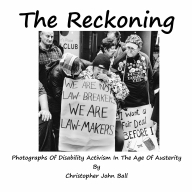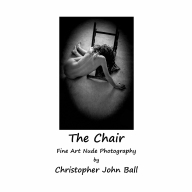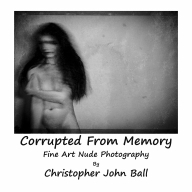
PHOTOGRAPHY AND THE OTHER - “Once you label me, you negate me” by Christopher John Ball

Tweet
Philosophers, such as Aristotle, Immanuel Kant and Wittgenstein, have long argued about the nature of beauty, aesthetics and the ever shifting values that we place upon what we see and observe; but what does it mean to be ‘seen’ by another and how does that impact upon us as individuals and how we perceive ourselves and our own appearance/beauty?
To further this examination I have drawn upon Jean Paul Sartre’s philosophy of existentialism as defined in his work ‘Being and Nothingness’. A key concept within Sartre’s philosophy is that of the Other - an individual/ Existent other than oneself who is singled out as different. Sartre argues that it is the Existent's definition of the Other forms part of what defines/constitutes both the self and cultural identity. It is also used by societies and groups to exclude Others whom they want to subordinate/oppress/control/make abject.
The starting point of Sartre’s philosophy of the Other is that the Existent does not derive the existence of the Other, by the Existents own cogito/thought, as something that it must prove. The Other is an undisputed fact whose existence is given simultaneously with its own and therefore can never be an object of knowledge. It is another I who is not I and never merely a probable object.Though the Existent encounters the Other within the depths of its own being; here it encounters not reasons for believing in the Others existence but the Other itself. The Other is not revealed as an object of knowledge but as a personal presence - although this Other must ultimately be understood as a subject. It usually makes its first appearance as an object which has come into the Existents field of vision or attention - though it soon becomes clear to the Existent that this object differs alarmingly from the other objects that surround it.
This alarm and unease is generated due to the sudden eruption into the Existents world of the Other as an object that threatens its stability. Stability is threatened because the Existent becomes aware that its world is one that can also be seen by the Other - resulting in the inescapable conclusion that the Existent cannot avoid being seen by this new Other. Further unease is created within the mind of the Existent due to the unavoidable conclusion that this new Other, upon seeing the Existent, cannot help but objectify it and make it part of its world. In Sartre’s Existentialism the world can only exist for a subject, and therefore the Existent knows that the Other is confronting it as a ‘subject’ who is ‘objectified’ even in the Existents own eyes.
At the initial sighting the Existent perceives the Other in terms of the spatiotemporal categories governing its attitude towards other objects - i.e. the Others distance from the Existent can be measured in feet and inches and details such as height and build can be assessed. At this stage if the Other were to disappear the Existents universe would not be radically altered. From the point at which the Other notices the Existents presence the Existents awareness of the Other, as being more than another object, becomes more acute.
Therefore the Existent can no longer view the Other’s relationship with its surroundings as merely the juxtaposition of similar things. What arises now is that, while the perception of the Existent towards the Other can still be described in terms of distance and so forth, there is a sudden change in the Existents own connections with the surrounding objects; i.e. they no longer belong to a spatiality that is purely the Existents as they are now part of a spatiality that is shared with the Other - the Existents whole universe is in danger of being thrown into confusion.
This Other is not only something that ‘sees’ what the Existent ‘sees’ - and in so doing helps to pull the Existents world out of 'shape’ - the Other is also a being who ‘sees’ the Existent. Therefore the Existents fundamental relationship to the Other must be defined in terms of being-seen and this becomes an irreducible relationship belonging to a world of everyday experience.
Not only has the ‘look’ of the Other disturbed the Existent’s universe, by being forced to accept that it is no longer its own, the Other has created the feeling within the Existent that it too has been absorbed into that universe as one of its objects.
Therefore, in looking at the Existent, the Other has transformed it into an object and, in so doing, has deprived the Existent of its 'transcendence' and 'subjectivity'. The Existent is robbed of its freedom and the possibilities which lie at the root of its existence are petrified and alienated by the Others look.
The ultimate effect this has on the Existent is that it becomes, as stated, an object in its own eyes and not just merely in the eyes of the Other. The Existent realises that it is no longer a free subject and has instead become an object; this is brought about not through knowledge but through the fact of the Others presence as a freedom other than the Existents own. This is what Sartre called ‘Being-for-Others’ and it is for the Existent to recognise this Being-for-Others and, in so doing, transcend it so as to give it meaning. For Sartre, the important aspect is not what the Other makes of the Existent but rather what the Existent makes of the Other. It could be argued that the above discussion could hold great relevance when applied to our understanding of photographic image and how it is ‘read’.
What would happen to the Existent if the Other, instead of just looking at the Existent, proceeds to photograph said Existent? For the sake of this argument let the camera be one of the instant image variety such as digital. Let us go back to the previously mentioned first sighting of the Other by the Existent. At first sighting the Existent would still be able to judge the Other as an object in spatiotemporal terms. If the Other were to disappear at this point the Existents world would not be radically altered. The Existents reaction to being noticed by the Other would remain the same as previously discussed i.e. an inability to treat the Other as a mere juxtaposition of things, the feeling of the Existents world being stolen and the confusion associated remaining.
The Other, instead of just looking, now begins to photograph the Existent. The Existent is aware of the camera as an object that can be used to record images that can be used to represent what the Other sees i.e. the Other’s world. As has been described, the Existent is also aware that its world is a world that can be seen by the Other and therefore it can be photographed by the Other, thus intensifying the Existents own sense of objectification.
This can be made more intense by the Other allowing the Existent to see the resulting images. The sense of unease experienced by many people, when either being photographed, or viewing the resulting images, draws testimony to this. Another factor arises out of this situation; the Other has made a decision as to when to make the image/s.
The creation of a work of art entails an individual Existent wanting something to exist that has certain properties through the said Existent; therefore a work of art is an appropriation because it expresses a synthesis of a ‘self’ and ‘not-self’ and becomes the creative embodiment of 'my' idea in a concrete Existent. This is now independent of its creator though it will always remain, in some sense, ‘mine.'
What happens when the subject of this art is another Existent? If it is an appropriation i.e. a form of exclusive possession of something set aside for future use, how does this affect the Existent? It cannot be said that the Existent photographed has become the property of the Other but photographs have been used, ever since the medium was invented, to say just this. One example would be during the time of slavery in the United States prior to the Civil War. Photographs were made of individuals who were thought of as ‘owned’ i.e. the Negro slaves. Prisoners are also photographed, have they not been 'appropriated' by the state? Photographs are used in contemporary society as means of identification, but what are they identifying?
They cannot, existentially be thought of as identification of an Existent due to the aforementioned changing qualities of said Existent. Photographs are, at best, what the Existent was not, what it is or is capable of being. Yet, when the Existent confronts its own image a sense of apprehension is often felt, nobody reacts neutrally to an image of themselves.
If the Other can show the photograph to the Existent, the Existent is aware that this photograph can then be shown to other Others. What happens to this photographic object when it is shown to other Others? By situating objects in context the Existent gives them meaning; therefore, as the photograph is an object, meaning is given to it by the viewing Existent.
Does this have an adverse effect upon the Existent depicted within the image? If one makes, what ‘could’ be described as, a pornographic image of a female Existent, how could it be viewed in existentialist terms?
If the viewing Existent is a heterosexual male, he will be aware of her as a sexual object - an object upon which to focus and direct his sexual desire. This of course comes as no surprise to the Existent
who acquired the image, or to the producer of the image, but the object that is being held and viewed is a photograph and not a woman. The male Existent viewing the image is capable of making or fetishising this photograph into a sexual object by appropriating sexual desire upon the image. In doing this, some would be argue, the male Existent objectifies sexually, not only the woman depicted in the image, but women in general. This is because he is Other than the subject; for him it constitutes no problem, he already sees himself as 'different.'
For a heterosexual female Existent viewing the image this 'difference’ as to gender does not exist. So how is the female Existent affected when viewing the image? She will be aware of the bodily similarities that she shares with the subject depicted, but she will also be aware that she is not the subject and is in fact Other too the subject.
She will be aware that what she is holding is a photograph, an object that 'holds' an image of something that is similar to her, yet different. Therefore, unlike the male who it could be argued has the distance he can place from the image on the grounds of gender i.e. sexual difference. Some may argue, if the subject is regarded as an object within a patriarchal society i.e. a sex object, is it any wonder that the female Existent feels that she too is an object?
If the photograph is regarded by the male viewer as depicting a sexually available object, then the female Existent, due to the special empathy arising from sexual similarities, sees herself as an available sexual object in the eyes of the Other.
In turn she will also see herself as a sexual object even in her own eyes for the same reasons as previously described in the section dealing with the Existent being seen by the Other within this chapter.
An argument often put forward is that ‘pornographic’ images degrade women because they are seen, not as depicting a woman, but women in general. The effect this has is adverse existentially because it anchors women in the object world by denying them individuality. This makes the task of transcending that which women are seen to be that much harder for the female Existent.
This also has an effect on the male; if the Existent feels unease due to the Existents world being thrown into confusion when viewed by the Other. Is this unease not then compounded by the Existent being attracted to the Other, when this Other is female?
This makes the sense of objectification more intense because the male Existent is attracted to the objectifier; the desire to escape the Others world makes the sense of entrapment more acutely felt. Of course this is not to imply that woman is the seducer/temptress as depicted in many fictions - the ‘Adam and Eve’ story being one example.
Whilst women are also sexual beings and attracted to the opposite sex, or same sex if homosexual, and therefore can react to an image of that upon which their desires fall, in much the same way, there is a fly in the ointment that has to be considered. Women, through no fault of their own, live in, what has been described as, a patriarchal society where power is weighted away from her. Some will argue that this creates an unfair advantage for the male Existent – one that increases the sense of objectification of women.
The male Existent has attempted to overcome his sense of unease at being attracted to the female Other by objectifying her, even in her own eyes, before she looks upon him. He is objectifying her before she can objectify him; it is almost as if she is an object before she enters his world. Therefore, to the male Existent, the female Other has been rendered as less of a threat, or even no threat, to his world due to her being, at best, only slightly removed from the object world. She is not simply an object but another Other who is not male, and is therefore set apart from objects but equally set apart from male Others. She could be described as being in a state of limbo.
It could be argued that the male Existents denial of the individuality of the female Other, taking away her opportunity to transcend that which she is ‘seen’ to be, places himself in a position where he is equally denying his own individuality and, in so doing, he condemns himself to an 'inauthentic existence'.
We have discussed how this relates to the opposite gender but what about Others that are seen as abject/absent – such as the disabled? Artists have often used disability as metaphor or analogy to convey ideas about evil, suffering, vulnerability, human frailty, punishment and sin – it has long been part of their vocabulary. Such themes were especially popular among European artists producing works based upon religious subject matter. The individuals with disabilities featured within these works have, more often than not, acted as passive cultural objects or signifiers. Rather than being seen as other Others the disabled are seen as physically different or ‘other to’ – apart or abject from Others.
People with, or to use the oft used alternative and more weighted term ‘suffer from’, a disability are rarely asked about how they should be portrayed – even within the creation of promotional material in support of a charity set up to alleviate their ‘problem’. The ‘disabled’ are hardly ever seen as, or encouraged to be, active creators and consumers of culture, art and media.
As has been discussed - feminists can argue that art, especially erotic art, objectifies women as sexual objects, passive and available. The disabled are also objectified but with the fundamental difference in that they are seen as not having sexuality, sexual identity or gender – they are ‘seen’ but in a manner that excludes them. It could be said that the very thought of the disabled having sex or having a sexual identity is, at best, uncomfortable to many and even repugnant to some – this is an uncomfortable truth.
Yet, in reality, the number of disabled people within a population is far higher than many would like to admit – especially as it would include many who would not consider themselves as disabled. The fact is if you are wearing glasses then you are disabled. Spectacles are of course a socially acceptable disability that even has its own multi million pound industry with support from designers and high end labels.Whilst not realising that they are doing so, many couples introduce disability into their sex play. A partner may blindfold another in an attempt to heighten the senses. This blindness, though temporary, is
thought of as an enhancement to pleasure… Yet we never say to a blind person ‘Hey, you must have great sex’. Another example maybe the binding of a partner by ropes to restrict movement – an enforced paralysis again created to enhance sexual play. There are those who fetishise particular disabilities and have used new technologies to create arenas where images of said disability, or appliance associated with a disability, can be admired and shared – though the role of the disabled individual being viewed is still passive and often without their knowledge or permission.
If it is a hard enough task for women to transcend that which they are ‘seen’ to be – their ‘being for others’ - then it must be that much harder for the disabled. The disabled Existent, viewing the Other, cannot help but see reflected back upon them that which society/culture labels as a non-aesthetic or an absence.
The photographs on this page are taken from a series entitled ‘Sometimes’ and are self portraits by the author of this piece. They are an attempt to explore, through image and text, some of the themes, explored within this essay, on how I may be seen, as a disabled person, by myself, others and the media.
As we become less of a democracy and move further towards a plutocracy those in power will increasingly, through popular culture, encourage and re-enforce this reflection in an attempt to negate/control difference and individuality or try to manipulate it, for example the act of selecting a scapegoat, as a means towards their own end.
The act of seeing and being seen are powerful weapons that, unless we each take steps to regain sovereignty, will be increasingly turned against each of us – black, white, male or female, gay or straight, able bodied or disabled. For as Soren Kierkegaard, whom some call the father of Existentialism, famously stated “Once you label me, you negate me”
July 2024 Several books, featuring Christopher John Ball's photographs, are now available through Amazon or click on an image below to purchase via secure payments on lulu.com

Tweet








